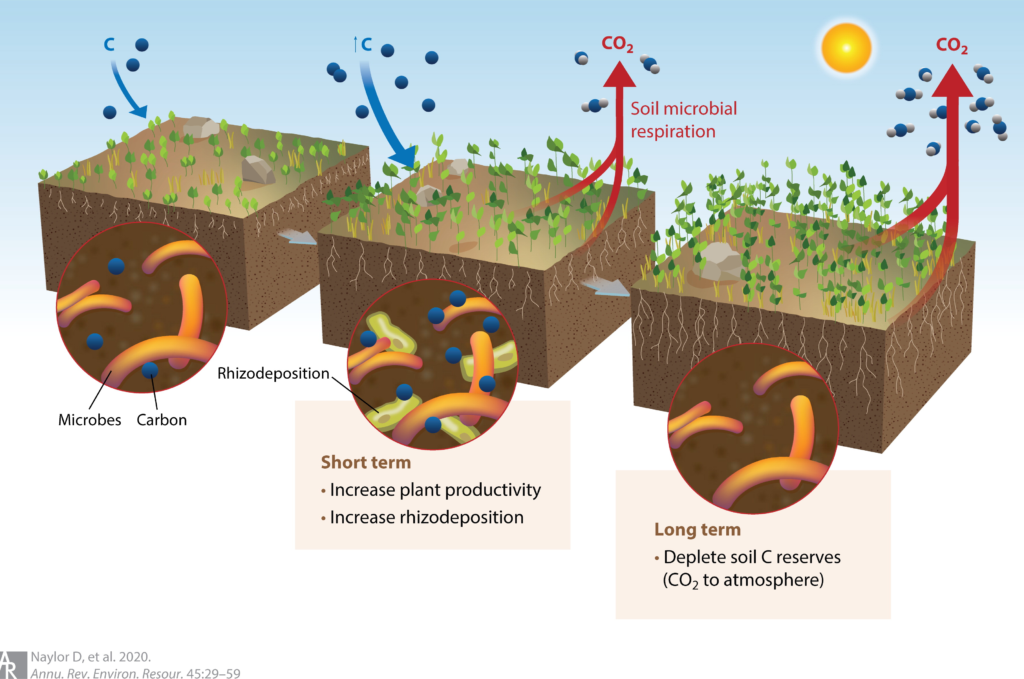
MCQ on Respiration in Plants MCQ on Respiration in Plants
1. Oxidation of one molecule of NADH gives rise to
a) 3 ATP molecules
b) 12 ATP molecules
c) 2 ATP molecules
d) 1ATP molecule
2. Aerobic respiratory pathway is appropriately termed as
a) Catabolic
b) Parabolic
c) Amphibolic
d) Anabolic
3. In alcohol fermentation,
a) There is no electron donor
b) Oxygen is the electron acceptor
c) Triose phosphate is the electron donor, while acetaldehyde is the electron acceptor
d) Triose phosphate is the electron donor, while pyruvic acid is the electron acceptor
4.In respiration breaking down of glucose with oxygen is known as
a) Oxidation process
b) Reduction process
c) Oxidation-oxaloacitation process
d) All of the above
5. Net gain of ATP molecules per hexose during aerobic respiration is
a) 12
b) 18
c) 36
d) 30
6. Which of these are respiratory poisons or inhibitors of electron transport chain?
a) Cyanides
b) Antimycin-A
c) Carbon monoxide
d) All of these
7. Kreb’s cycle is completed with the formation of
a) Citric acid
b) Oxaloacetic acid (OAA)
c) Succinic acid
d) Malic acid
8. Where is ATP synthesised in glycolysis?
a) When 1, 3 di PGA is changed into 3PGA
b) When glucose is converted into glucose-6-phosphate
c) Both (a) and (b)
d) When, 1, 6 diphosphate is broken in triose phosphate
9. Maximum number of ATP is obtained from
a) Glucose
b) Palmitic acid
c) Malic acid
d) β-amino acid
10. Glycolysis takes place in
a) All living cells
b) Eukaryotic cells only
c) Prokaryotic cells only
d) None of these
MCQ on Respiration in Plant
We would Like your Valuable Feedback
11. Krebs’ cycle begins with the reaction
a) Citric acid +acetyl Co-A
b) Oxaloacetic acid + pyruvic acid
c) Oxaloacetic acid + citric acid
d) Oxaloacetic acid + acetyl Co-A
12. Co-Factor required for formation of acetyl Co-A is
a) TPP
b) Lipoic acid
c) Mg2+, Co-A
d) All of these
13. In anaerobic respiration in plants
a) Oxygen is absorbed
b) Oxygen in released
c) Carbon dioxide is released
d) Carbon dioxide is absorbed
14. The respiratory quotient (RQ) of some of the compounds are 4,1 and 0.7. These compounds are identified respectively as
a) Malic acid, palmitic acid and tripalmitin
b) Oxalic acid, carbohydrate and tripalmitin
c) Tripalmitin, malic acid and carbohydrate
d) Palmitic acid, carbohydrate and oxalic acid
15. The enzyme ….. is used to catalysed when condensation of acetyl group with oxaloacetic acid and to yield citric acid
a) Citrate permeate
b) citrate synthase
c) Citrate burate
d) Citrate maliate
16. The respiratory quotient (RQ) of a germinating castor seed is
a) Equal to one
b) Greater than one
c) Less than one
d) Equal to zero
17. Glycolysis
I. causes partial oxidation of glucose (one molecule) to form 2-molecules of pyruvic acid and 2 ATP as net gain
II. takes place in all living cells
III. uses 2 ATP at two steps
IV. scheme was given by Gustav Embden, Otto Mayerhof and J Parnas
Choose the correct option containing appropriate statements from the above
a) I, II and III
b) I, II and IV
c) I, II, III and IV
d) Only I
18. During oxidative phosphorylation, the net gain of ATP is
a) 40
b) 38
c) 34
d) 30
19. Decarboxylation is involved in
a) Electron transport system
b) Glycolysis
c) Krebs’ cycle
d) Lactic acid fermentation
20. Alternate name of TCA cycle is
a) Kreb’s cycle
b) Grab’s cycle
c) Mayerhoff cycle
d) Embden cycle
MCQ on Respiration in Plants
1 (c)
The energy released by oxidation in respiration is not directly used but it stored as ATP. Which is broken down whenever energy needs to be utilized
2 (c)
RQ is one in case of carbohydrates, while for fatty acids is less than one and for organic acids RQ is more than one.
3 (a)
Sucrose or cane sugar is widely distributed among higher plants. Its commercial sources are solely sugarcane and beet. It is used as substrate for the formation of alcohol.
4 (b)
The correct sequence in glycolysis is
Glucose-6-phosphate → 3-phosphoglyceraldehyde
Phosphoenol ←3-phosphoglyceric acid↲
Pyruvate
↓
Pyruvic acid.
5 (a) Cyanide is a deadly poison of respiration and inhibit the activity of cytochrome-c oxidase complex (which contains cytochrome-a and cytochrome-a3) of electron transport chain of aerobic respiration. Thus, no proton gradient will be established and no ATP will be formed. Along with as the reduction of NADH and FADH2 is also ceased due to blockage of ETS, the availability of hydrogen acceptors like NAD+ and FAD is ceased for Krebs’ cycle and glycolysis. Cyanide resistance pathway is anaerobic respiration
6 (a) Hexokinase causes phosphorylation of glucose to glucose-6 phosphate in both glycolysis and pentose phosphate pathway. Both glycolysis and phosphate pathway occur in cytoplasm.
7 (b)
The aerobic respiration takes place within the mitochondria, the final product of glycolysis pyruvate is transported from the cytoplasm into the mitochondria. The major events in aerobic respiration are
The complete oxidation of pyruvate by the stepwise removal of all the hydrogen atoms, leaving 3 molecules of CO2.
The passing on of the electrons removed as part of the hydrogen atoms to molecular O2 with simultaneous synthesis of ATP
8 (b)
Glycolysis is an essential and first path of respiration. It is common in both aerobic and anaerobic respiration and occurs in the cytosol of all living cells of prokaryotes as well as eukaryotes
9 (d)
Oxidative phosphorylation or ATP synthesis from NADH occur only under aerobic condition.
10 (d)
In ethyl alcohol fermentation
11 (c)
The activity of succinate dehydrogenase is inhibited by Malonate.
12 (a)
Citric acid is produced by the fermentation of sugar by Aspergillus niger, Mucor sp and yeast.
13 (a)
In the process of respiration the compound, i.e., glucose reacts with oxygen which is called oxidation therefore organic substance gets oxidized
14 (b)
Pyruvate is broken down to CO2 and H2O in citric acid of tricarboxylic acid cycle (TCA)
15 (a)
Preparatory phase before fermentation is called upstream processing while downstream processing is the name given to the stage after fermentation, when the desired product is recovered and purified.
16 (d)
Retting is facilitated by anaerobic butyric acid bacteria such as Clostridium botulinum, Clostridium tetani and Clostridium perfringens.
17 (b)
RQ is the ration of the volume of carbon dioxide released to the volume of oxygen taken in respiration. It depends on the nature of the substrate, which is oxidized. For carbohydrates RQ is one, for fats and proteins less than one but more than one for organic acids, etc.
18 (d)
The complex V of ETS of mitochondrial membrane is ATP synthase, which has a head piece, stalk and a base piece. Out of these, the head piece is identified as the coupling factor 1(F1), stalk portion is necessary for binding i to inner mitochondrial membrane and base piece is isolated as F_0 and present within the inner mitochondrial membrane.
19 (a)
Protein breaks down into amino acid then enter into the glycolytic pathway
20 (d)
Ethyl alcohol is commercially manufactured from sugarcane. Molasses is the byproduct of sugar industry. Ethanol is produced by the fermentation of molasses (contains glucose and fructose) by using yeast, Saccharomyces cerevisiae.

… [Trackback]
[…] Here you will find 44083 more Information to that Topic: eklabhyaclasses.com/blog/mcq-on-respiration-in-plants-2/ […]
… [Trackback]
[…] Information on that Topic: eklabhyaclasses.com/blog/mcq-on-respiration-in-plants-2/ […]